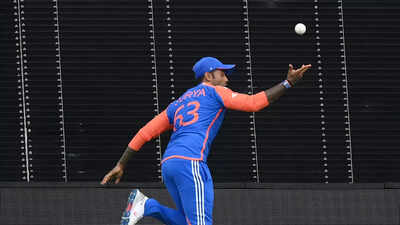The International Cricket Council (ICC) has unveiled a series of significant changes to its playing conditions, impacting Test, ODI, and T20I cricket. These adjustments address areas such as over rates, ball usage, boundary catches, concussion protocols, and wide ball rulings.

Celebrating a wicket! The ICC's updated rules aim to add more excitement and fairness to the game.
To combat slow over rates, a stop clock will now be permanently used in Test matches, following successful trials in shorter formats. After an over is completed, the fielding team must commence the next over within 60 seconds. Teams will receive two warnings per innings, with subsequent breaches resulting in a five-run penalty. These warnings will reset after every 80 overs, coinciding with the availability of a new ball.
In One Day Internationals (ODIs), the use of two balls will now be limited to the initial 34 overs. For the remaining 16 overs, the fielding side will have the option to select one of the two balls for continued use. This change aims to better manage the wear and tear of the ball during the innings.
A significant adjustment has been made to the boundary catch rule. Fielders making airborne contact with the ball beyond the boundary must now land completely within the field of play to complete a legal catch. If a fielder steps outside the boundary and jumps again, they are allowed only one additional touch before landing inside the boundary.
To prioritize player safety, teams will now be required to pre-nominate concussion substitutes. Any player diagnosed with a concussion must undergo a mandatory seven-day rest period before being permitted to return to competitive play.
A new rule regarding wide balls will be tested in white-ball cricket. The batter’s position at the time of delivery, rather than after any subsequent movement, will be used to determine whether a delivery is a wide. Deliveries passing between the leg stump and the extended protected area marker at the popping crease will no longer be called wide. However, deliveries passing behind the batter's legs may still be considered wide. To aid umpires in making these decisions, the protected area marker will be extended to the popping crease, serving as a clear visual guide.
The Decision Review System (DRS) will now utilize the actual physical outline of the stumps and bails to define the wicket zone, thus increasing the precision of LBW (leg before wicket) decisions.
In addition to the existing five-run penalty for a deliberate short run, the fielding team will now have the prerogative to choose which batter takes strike for the subsequent delivery.
For domestic first-class cricket, a new rule allows a team to replace a player who sustains a serious on-field injury – including during warm-ups – with a like-for-like player for the remainder of the match.
The new Test playing conditions were implemented starting with the Sri Lanka vs. Bangladesh Test match on June 17th. The updated ODI and T20I rules will take effect from the same series, commencing with the first ODI on July 2nd and the T20Is on July 10th. All international matches occurring after these dates will be governed by the updated regulations.
Newer articles
Older articles
 Team India Settles in Birmingham: Rahul's Mattress, Coaches' Strolls, and the Enduring Coffee Ritual
Team India Settles in Birmingham: Rahul's Mattress, Coaches' Strolls, and the Enduring Coffee Ritual
 Android Users Urged to Patch Devices Immediately Following Critical Security Flaws Alert
Android Users Urged to Patch Devices Immediately Following Critical Security Flaws Alert
 Ashada Gupt Navratri 2025: Dates, Auspicious Timings, and Esoteric Significance Explained
Ashada Gupt Navratri 2025: Dates, Auspicious Timings, and Esoteric Significance Explained
 JPG to PDF: A Graphic Designer's Guide to Conversion & Best Practices
JPG to PDF: A Graphic Designer's Guide to Conversion & Best Practices
 Skin Cancer Alert: How to Identify Suspicious Moles and Early Warning Signs
Skin Cancer Alert: How to Identify Suspicious Moles and Early Warning Signs
 IRCTC's AskDisha 2.0: AI Chatbot Streamlines Train Ticket Booking, Refunds, and Travel Information
IRCTC's AskDisha 2.0: AI Chatbot Streamlines Train Ticket Booking, Refunds, and Travel Information
 The stat that could swing every NBA team's 2025-26 season
The stat that could swing every NBA team's 2025-26 season
 Bollywood's Mythological Muse: How Indian Epics Inspire Cinematic Storytelling
Bollywood's Mythological Muse: How Indian Epics Inspire Cinematic Storytelling
 Bollywood Flashback: Jackie Shroff Accused of Untoward Advance on Young Tabu at Danny Denzongpa's Party
Bollywood Flashback: Jackie Shroff Accused of Untoward Advance on Young Tabu at Danny Denzongpa's Party
 Popular Finance YouTuber's Account Hacked: Bitcoin Scam Alert and Security Tips
Popular Finance YouTuber's Account Hacked: Bitcoin Scam Alert and Security Tips